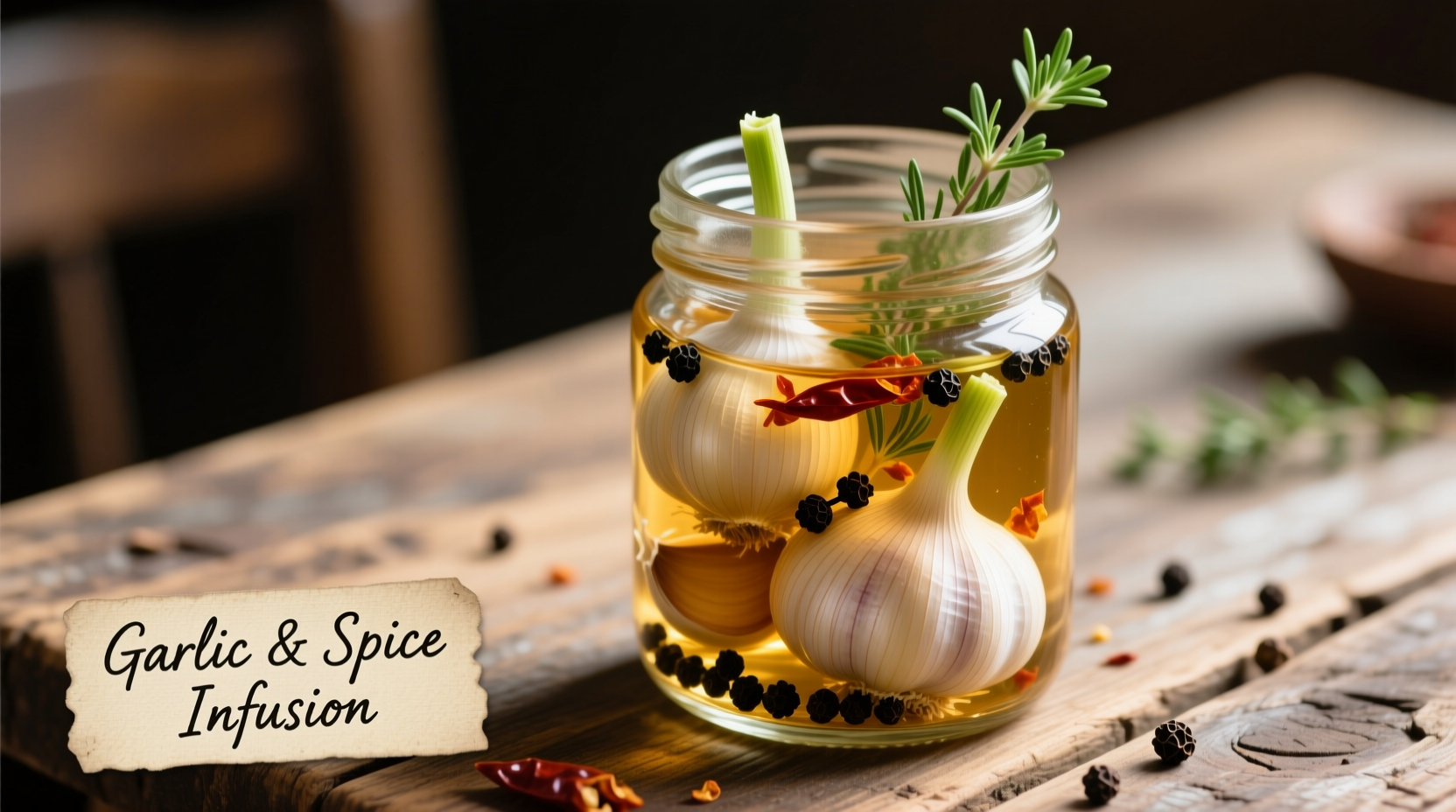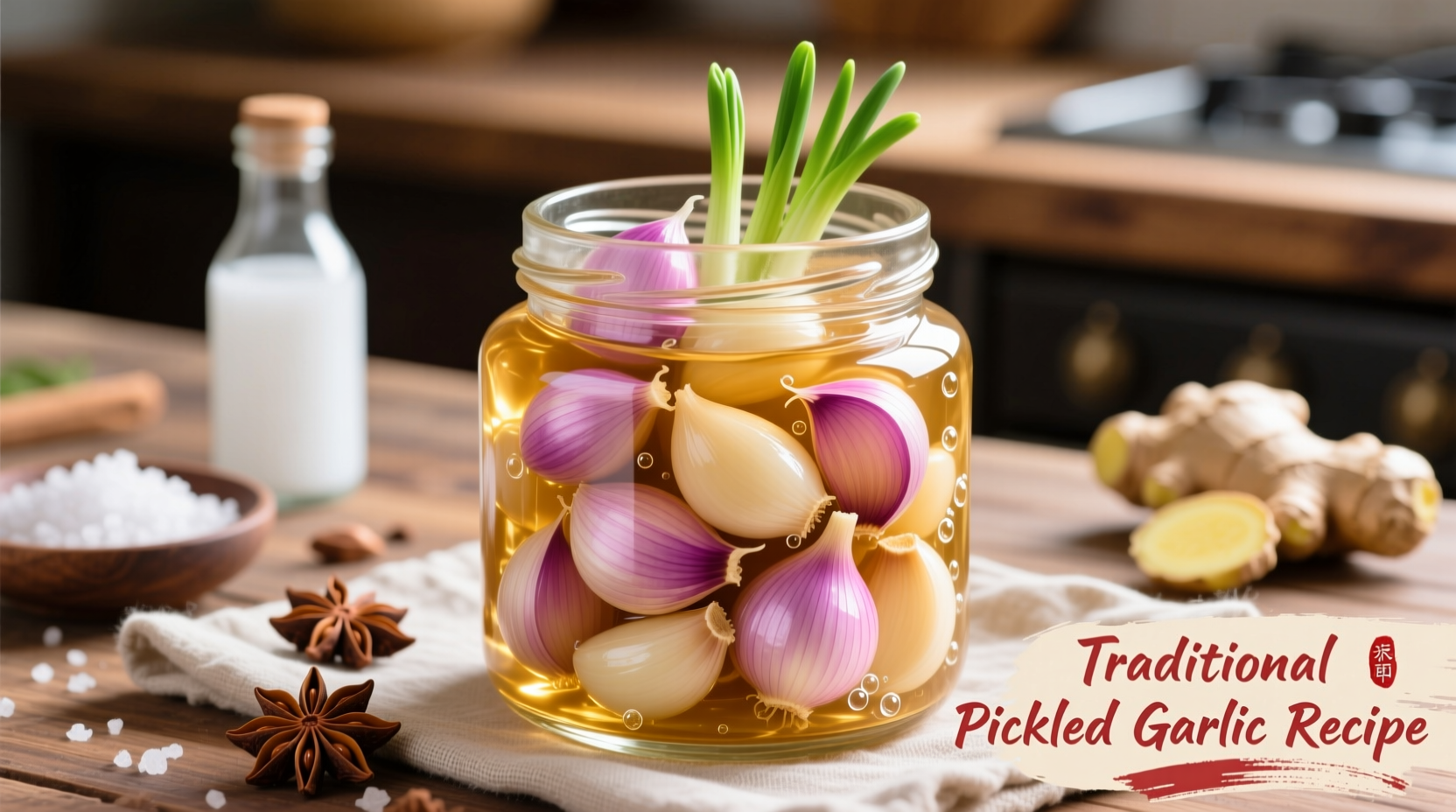Discover how to make perfect pickled garlic at home with this foolproof recipe that requires just 5 ingredients and 20 minutes of active time. Your pickled garlic will be ready to eat in 2 weeks and safely stored for up to 1 year when following proper canning techniques with vinegar at 5% acidity or higher and maintaining pH below 4.6 for food safety.
There's nothing quite like the tangy, mellow flavor of homemade pickled garlic. Unlike store-bought versions that often contain artificial preservatives, crafting your own pickled garlic lets you control the ingredients while creating a versatile condiment that elevates everything from salads to roasted meats. As a culinary professional who's taught thousands of home cooks the science behind flavor extraction, I've perfected this method through years of testing different vinegar ratios, spice combinations, and processing techniques.
Whether you've harvested your own garlic or bought a surplus at the farmers market, pickling preserves this pungent bulb while transforming its sharp bite into something complex and nuanced. The process works through acidification—when garlic sits in vinegar, the pH drops below 4.6, creating an environment where harmful bacteria cannot survive. According to the National Center for Home Food Preservation, this pH threshold is critical for preventing botulism in home-canned products.
Why Your Garlic Pickling Success Starts With Vinegar Selection
The type of vinegar you choose dramatically impacts both safety and flavor. Not all vinegars work equally well for pickling—distilled white vinegar with 5% acidity provides the consistent results needed for safe preservation, while wine vinegars offer more complex flavor profiles but require careful pH monitoring.
| Vinegar Type | Acidity Level | Best For | Flavor Notes |
|---|---|---|---|
| Distilled White | 5% (standard) | Basic preservation | Clean, sharp tang |
| Apple Cider | 5-6% | Balanced flavor | Fruity undertones |
| White Wine | 5-7% | Gourmet applications | Subtle complexity |
| Rice Vinegar | 4-5% | Asian-inspired recipes | Mild, delicate |
Remember that vinegar concentration directly affects safety—never dilute vinegar below 5% acidity for pickling. The U.S. Food and Drug Administration requires this minimum concentration to ensure proper preservation. I've seen many home canners compromise safety by using homemade vinegars with unknown acidity levels, which risks dangerous bacterial growth.
Essential Equipment Checklist
Before you begin, gather these kitchen tools that make the process efficient and safe:
- 1-quart mason jars with new lids (avoid reusing old lids)
- Canning funnel for mess-free filling
- Long-handled non-reactive spoon (stainless steel or wood)
- Small saucepan for heating vinegar mixture
- PH test strips (critical for non-standard vinegar blends)
- Jar lifter for safe handling of hot containers

Step-by-Step Pickling Process
Follow these professional-tested steps for consistently delicious results:
Preparation Phase (10 minutes)
- Peel 12-15 garlic cloves, keeping them as whole as possible
- Wash jars in hot soapy water and sterilize by boiling for 10 minutes
- Prepare flavor additions: 1 dried chili, 1 teaspoon black peppercorns, 2 sprigs fresh thyme
Brine Creation (5 minutes)
Combine in a saucepan:
- 1 cup distilled white vinegar (5% acidity)
- ½ cup water
- 1½ tablespoons pickling salt (never use table salt with anti-caking agents)
- 1 tablespoon sugar (optional for balanced flavor)
Bring to a gentle simmer, stirring until salt and sugar dissolve completely. Do not boil vigorously as this can reduce acidity.
Packing and Sealing (5 minutes)
- Place garlic cloves and flavorings into sterilized jars
- Pour hot brine over garlic, leaving ½ inch headspace
- Remove air bubbles by running a non-metallic utensil along jar sides
- Wipe rims clean with a damp cloth before applying lids
- Process in a boiling water bath for 10 minutes for proper seal formation
Storage Guidelines You Can Trust
Proper storage determines both safety and flavor development. According to research from the National Center for Home Food Preservation, correctly processed pickled garlic maintains quality for 12-18 months when stored in a cool, dark place. Refrigeration after opening extends freshness for 3-4 months.
Watch for these signs of spoilage that indicate the jar should be discarded immediately:
- Bulging lid or broken seal
- Cloudy brine with sediment (beyond normal spice settling)
- Foul odor upon opening
- Mold growth of any kind
Creative Ways to Use Your Homemade Pickled Garlic
Move beyond basic applications with these chef-inspired ideas:
- Chop finely and mix with mayonnaise for an exceptional sandwich spread
- Add whole cloves to Bloody Mary cocktails for a savory kick
- Blend with olive oil and herbs for a quick pasta sauce
- Include in grain bowls for tangy contrast against earthy ingredients
- Use the flavorful brine as a salad dressing base
Troubleshooting Common Pickling Problems
Even experienced home canners encounter issues. Here's how to fix them:
Cloudy Brine
Cause: Minerals in hard water or table salt with anti-caking agents
Solution: Always use distilled water and pickling salt in future batches. Current batch remains safe if properly processed.
Bitter Flavor
Cause: Over-processing or using garlic that's past its prime
Solution: Consume within 6 months for best flavor. Next time, use fresher garlic and reduce processing time by 2 minutes.
Soft Garlic Cloves
Cause: Overexposure to heat during processing
Solution: Reduce water bath time by 2-3 minutes. Note that softness doesn't indicate spoilage if pH remains below 4.6.
Safety First: Critical Considerations
Pickling seems simple but requires attention to food safety details. The World Health Organization emphasizes that improper acidification creates ideal conditions for Clostridium botulinum growth. Always verify your final product's pH stays below 4.6 using calibrated test strips—this isn't just recommended, it's essential for preventing foodborne illness.
Never attempt to pickle garlic in olive oil at room temperature—a practice that has caused multiple botulism outbreaks. The USDA explicitly warns against this method as oil creates an anaerobic environment where botulism spores can thrive, even in acidic conditions.
Flavor Variations to Explore
Once you've mastered the basic technique, experiment with these professional variations:
- Mediterranean Style: Add rosemary, lemon zest, and a bay leaf
- Asian Fusion: Include star anise, ginger slices, and rice vinegar
- Spicy Kick: Double the chili content and add a pinch of red pepper flakes
- Sweet & Tangy: Increase sugar to 2 tablespoons and add orange slices
Remember that flavor development continues for 4-6 weeks after processing. While your pickled garlic becomes safe to eat after 2 weeks, waiting the full month creates significantly more complex flavors as the garlic fully absorbs the brine.
Frequently Asked Questions
How long does homemade pickled garlic last?
Properly processed and sealed pickled garlic maintains quality for 12-18 months in a cool, dark pantry. Once opened, store in the refrigerator and consume within 3-4 months for best flavor and safety.
Can I use apple cider vinegar instead of white vinegar for pickling garlic?
Yes, you can use apple cider vinegar with 5% acidity or higher, but monitor pH carefully as fruit-based vinegars can vary. The final product should maintain pH below 4.6 for safety. Apple cider vinegar creates a slightly fruitier flavor profile that works well with roasted meats.
Why did my pickled garlic turn blue or green?
This natural color change occurs when garlic's anthocyanins react with acidic brine, especially in immature garlic. It's completely safe and doesn't affect flavor. The color typically returns to normal after several weeks as the pickling process continues.
Do I need to refrigerate pickled garlic before opening?
No, properly processed and sealed pickled garlic (with pH below 4.6) can be stored at room temperature until opened. Refrigeration after opening extends freshness and prevents flavor degradation. Never store unprocessed garlic in vinegar at room temperature.
Can I reuse the pickling brine?
Yes, the brine makes an excellent salad dressing base or marinade. Strain out solids, store in a clean container in the refrigerator, and use within 2-3 weeks. The brine will have absorbed garlic flavor, making it perfect for vinaigrettes or as a cooking liquid for grains.











 浙公网安备
33010002000092号
浙公网安备
33010002000092号 浙B2-20120091-4
浙B2-20120091-4